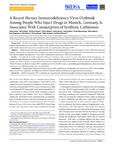2020-05-27Zeitschriftenartikel
A Recent Human Immunodeficiency Virus Outbreak Among People Who Inject Drugs in Munich, Germany, Is Associated With Consumption of Synthetic Cathinones
Hanke, Kirsten
Fiedler, Stefan
Grumann, Christina
Ratmann, Oliver
Hauser, Andrea
Klink, Patrycja
Meixenberger, Karolin
Altmann, Britta
Zimmermann, Ruth
Marcus, Ulrich
Bremer, Viviane
Auwärter, Volker
Bannert, Norbert
Background.
Needle and syringe sharing among people who inject drugs (PWID) can result in a rapid regional spread of a human immunodeficiency virus (HIV) variant. Such outbreaks have been identified recently in several countries and have raised public health attention because of an association with new psychoactive substances (NPS).
Methods.
Dried serum spots from approximately 60% of newly diagnosed HIV cases in Germany in 2013–2018 were received together with statutory notification data. Samples were sequenced in the pol-region, genotyped, and viral phylogenies were analyzed. For selected samples, the hepatitis C virus (HCV) status and the presence of NPS were determined.
Results.
An outbreak of closely related 27 subtype C infections with a core of 11 cases with almost identical sequences was identified using phylogenetic analyses. The first case of the outbreak was diagnosed in 2015, and the last one was in 2018. With exception of 3 infections, all were reported from Munich, the capital of the federal state of Bavaria. Of 26 analyzed outbreak members, 24 (92.3%) had a resolved or viremic HCV coinfection. In 8 of 18 (44%) cases, α-pyrrolidinopentiothiophenone and/or the related
substance α-pyrrolidinoheptiophenone was identified.
Conclusions.
Despite harm reduction services in place, HIV outbreaks of considerable size can occur in PWID. The establishment of a real-time molecular surveillance is advised to rapidly identify outbreaks and target prevention measures.
Dateien zu dieser Publikation

